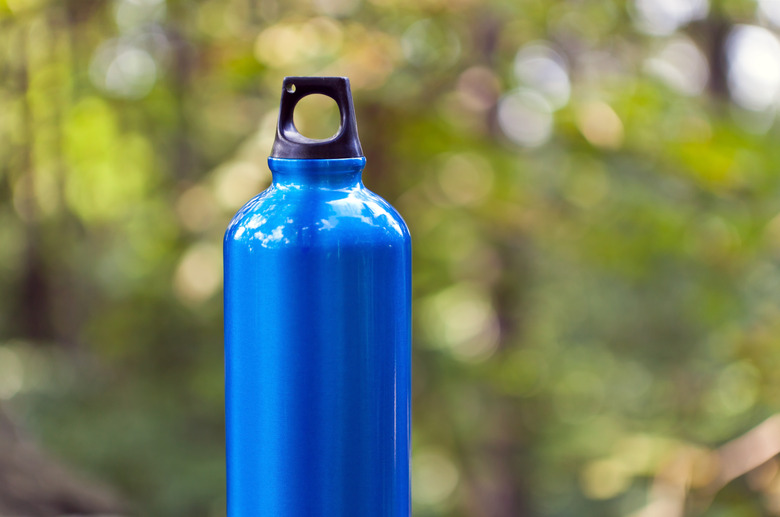Does A Drink Stay Colder In A Metal Can Or A Plastic Bottle?
While plastic drink containers present a number of issues for consumers, one of the advantages of these containers is lower thermal conductivity compared to metal containers. What this should mean for consumers is that, when left on a table or held in the hand, drinks would tend to stay colder for longer in a plastic container. When you factor in the effects of air currents, though, the two types of containers probably perform about the same. However, if you have cans of soda at room temperature, and you want to chill them quickly to get ready for a picnic, you'll have more success with metal cans than with plastic bottles.
TL;DR (Too Long; Didn't Read)
Even though metals conduct heat faster than plastics, experiments suggest that liquids in metal containers stay cold about as long as they do in opaque or semi-transparent plastic ones.
Quantifying Heat Transfer
Quantifying Heat Transfer
Scientists quantify the ability of a material to transfer heat by its thermal conductivity, denoted by the lowercase Greek letter lambda, or λ. This quantity expresses the amount of power transferred per unit of distance and per degree of temperature. In the MKS system, its units are watts per meter Kelvin, or W/(m⋅K).
Metals have conductivities in a range from tens to hundreds of watts per meter Kelvin. Most metal cans are made of aluminum, which has a thermal conductivity of 205 W/(m⋅K). Plastic, on the other hand, has a thermal conductivity around 0.02 to 0.05 W/(m⋅K). That's a difference of five orders of magnitude, which means aluminum transfers a hundred thousand times more heat per unit of distance than a plastic at the same temperature.
Aluminum vs. Glass
Aluminum vs. Glass
Glass has a thermal conductivity of 0.8 W/(m⋅K), which is a little more than 10 times that of plastic, but still 10,000 less than metal. While this suggests a drink in a glass bottle will warm less quickly than one in a metal can, experiments show that they warm at about the same rate. This paradoxical behavior is the result of how radiant heat transfer from the containers interacts with convection patterns in the surrounding air. A comparable experiment using plastic containers might arrive at a similar result, but one thing it almost certainly won't demonstrate is the liquid in the metal container staying cold longer than that in the plastic one. There's one condition, though. The plastic must be opaque or semi-transparent.
Clear Plastic
Clear Plastic
Many soft drinks come in clear plastic bottles, and if you place one of these in the sun, ultraviolet sunlight can reach the liquid inside and heat it. As a result, the liquid will heat more quickly than if it was in an opaque metal container, especially considering the bottle could act as a lens and magnify the sunlight. This effect can more than compensate for the difference in thermal conductivities. Leaving drinks in the sun isn't advisable if you want them to stay cold, but sometimes, you don't have a choice, and if not, it probably won't matter much whether the container is plastic or aluminum.
Cans Are Better for Ice Chests
Cans Are Better for Ice Chests
Warm drinks will cool faster in the refrigerator or in an ice chest if they are in aluminum cans than if they are in plastic bottles. In a confined space in which air currents aren't a factor, the higher thermal conductivity of aluminum provides for faster and more efficient heat transfer. So if you're at a picnic, and you have an ice chest to keep your drinks cold, purchase the drinks in aluminum cans. They will cool off more quickly in ice, and they may stay cold longer, too.
Cite This Article
MLA
Deziel, Chris. "Does A Drink Stay Colder In A Metal Can Or A Plastic Bottle?" sciencing.com, https://www.sciencing.com/drink-metal-can-plastic-bottle-5518851/. 11 April 2018.
APA
Deziel, Chris. (2018, April 11). Does A Drink Stay Colder In A Metal Can Or A Plastic Bottle?. sciencing.com. Retrieved from https://www.sciencing.com/drink-metal-can-plastic-bottle-5518851/
Chicago
Deziel, Chris. Does A Drink Stay Colder In A Metal Can Or A Plastic Bottle? last modified March 24, 2022. https://www.sciencing.com/drink-metal-can-plastic-bottle-5518851/
